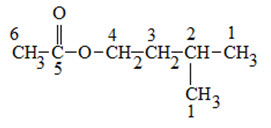Q.3.(c) Spectrum editing DEPT spectra and applications
Ans.3. (c)DEPT
[adsense:336x280:8701650588]
A very useful sequence in 13C spectroscopy is employed in the experiment called Distortionless Enhancement by Polarization Transfer, better known as DEPT. The DEPT method has become one of the most important techniques available to the NMR spectroscopist for determining the number of hydrogens attached to a given carbon atom. The pulse sequence involves a complex program of pulse and delay times in both the 1H and 13C channels. The result of this pulse sequence is that carbon atoms with one, two, and three attached hydrogen exhibit different phases as they are recorded. The phases of these carbon signals will also depend on the duration of the delays that are programmed into the pulse sequence.
In one experiment called a DEPT-45- in which only carbon atoms that bear any number of attached hydrogen will produce a peak.
A second experiment called DEPT-90- shows peak only for those carbon atoms that are part of amethine (CH) group.
A third experiment called DEPT-135- in which methine and methyl carbons give rise to positive peaks, whereas methylene carbons appears as inverse peaks.
Quaternary carbons, which have no attached hydrogen, give no signal in a DEPT experiment.
There are several variations on the DEPT experiment. In one form, separate spectra are traced on a single sheet of paper. On one spectrum, only the methyl carbons are shown, on the second spectrum, only the methylene carbons are traced, on the third spectra, only the methine carbons appear, and on the fourth trace, all carbon atoms that bear hydrogen atoms are shown.
In another variation on this experiment, the peaks due to methyl, methylene, and methine carbons are all traced on the same line, with the methyl and methine carbons appearing as positive peaks and the methylene carbons appearing as negative peaks.
For example –Isopentyl acetate

Applications:
1). DEPT is a spectral editing sequence, that is, it can be used to generate separate 13C subspectra for methyl (CH3), methylene (CH2), and methine (CH) signals.
2). DEPT makes use of the generation and manipulation of multiple quantum coherences to differentiate between the different types of 13C signals.
3). The Distortionless Enhancement by Polarization Transfer (DEPT) sequence uses polarization transfer from protons to other nuclei via one covalent bond to increase signal strength.










